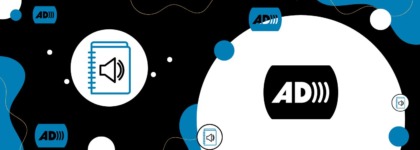When to Use Audio Description on Your Content
With anticipated updates to Title II of the ADA, ensuring accessible media has never been more top-of-mind. Audio description (AD) is one essential aspect of the upcoming requirements, and we’re here to help when it comes to narrowing down the what, when, and how of effectively implementing AD.
When to use audio description
The process of audio describing is highly nuanced, particularly when it comes to understanding what should/shouldn’t be described, when you should describe it, and how to describe it. Finding the right balance takes time, and we’ve compiled some key guidelines for understanding impactful and compliant descriptions.
Describe what’s observable and essential
The role of audio description is to narrate only what can be seen, not what can be assumed or interpreted. Focus primarily on describing:
- on-screen text and graphics
- speaker and scene changes
- facial expressions
- other critical actions or details, like costumes, gestures, etc.
Refrain from editorializing
It’s essential to refrain from asserting narrative interpretations or assumptions in AD. Objective, straightforward descriptions ensure the viewer receives accurate and unbiased information, which allows for independent understanding of the content. Forcing a subjective perspective can potentially mislead the audience, which undermines the purpose of AD as an equitable and reliable accommodation.
Integrate descriptions with natural pauses
Ideally, descriptions should fit naturally into pauses between dialogue or action. For video creators, this may look like intentionally leaving room during production for descriptions to be added in post-production.
This is especially important if the information being conveyed visually is not conveyed audibly. For example, a silent montage in a training video may require audio descriptions such as:
A woman types on a laptop in a busy office.
The screen shows a report titled ‘Quarterly Sales.’
What if the description doesn’t fit?
One of the most common obstacles in creating audio description is trying to fit a lot of information into a very short window of time. Sometimes, it’s just not possible – but don’t worry, we’ve got some alternative solutions up our sleeve.
Extended audio description
The original media can be paused to allow additional time for descriptions to be inserted, which is an ideal approach for complex content with significant visual details (like movie trailers). Watch an example of extended AD below.
Static text alternatives
For simpler videos without time-sensitive visuals (like lectures or ‘talking head’ videos), a written description may be a viable option. However, this may not be suitable for media with multiple speakers and/or dynamic visuals.
Can I create my own audio description?
Audio description is often necessary, but there are a couple best practices for inclusive media production that content creators can use to minimize (or altogether eliminate) the need for added descriptions in the post-production stage.
Verbally convey visual information
Anticipating the needs of blind and low-vision users during the content creation/recording phase is the best way to naturally incorporate descriptions. For example, it’s common to reference on-screen elements during lectures and presentations – rather than saying “as you can see,” it’s best practice to briefly outline the general function of the graphic, chart, or image.
The chart shows two lines moving upward, resulting in a 15% increase.
This kind of proactive approach reflects the core principles of Universal Design for Learning (UDL), a school of thought which emphasizes that content should be designed for inclusivity and accessibility from the beginning. UDL can be used as a benchmark during content creation to ultimately reduce the need for post-production enhancements like AD.
Distinctly identify speakers
Announcing speaker names as well as changes in speaker allows viewers to follow the conversation, especially in formats with multiple speakers. It can also be helpful to vary tone, volume, and pacing to better differentiate and contextualize.
I’m happy to hand this presentation over to [Speaker Name].
Audience participation is narrated
If your content includes audience involvement, like asking for a show of hands, make it a point to verbally relay the outcome.
About half of the audience raised their hands.
When best practices like these are followed during the content creation phase, it creates an equitable experience for your viewers – and compliant production experience for you.
How to prioritize audio described content
Despite the upcoming requirements, we know that implementing audio description doesn’t happen overnight. When deciding which content to prioritize for AD, start by focusing on the materials that are most visible or impactful to your audience – think about the first five clicks from your main website. These are typically the most trafficked pages that often serve as the face of your organization. Online course-style content should also be a priority, particularly since this content often features higher production value and clearer audio.
Based on industry trends we’ve observed, organizations are beginning to prioritize AD efforts as follows:
- Accommodation requests are considered highest priority. These are specific requests for access that are non-negotiable and must be addressed.
- Public website content is a close second. This content reflects your brand’s public commitment to inclusivity and compliance.
- High-visibility instructional content may not be addressed immediately, but should be addressed when a scalable solution is available.
- Backlog content is often last on the list of priorities, given that it typically has much lower viewership.
Evaluating your content through a similar lens can focus organizational efforts on areas that deliver the most impact and ROI, enabling a strategic approach to AD that aligns with your existing resources and future accessibility goals.
Disclaimer: this blog post provides general information and should not be considered legal advice. For specific guidance on compliance with the Americans with Disabilities Act, please consult with legal professionals.





